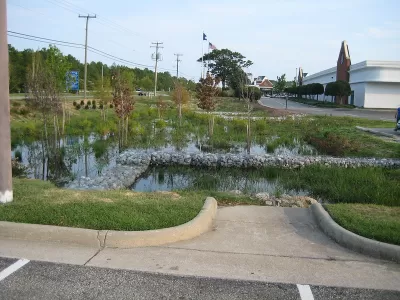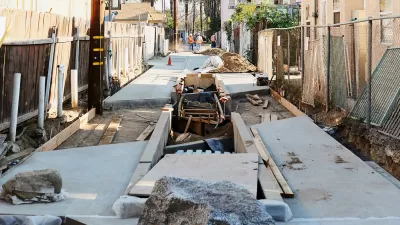How ‘sponge cities’ can protect residents and conserve water.

In an opinion piece in Next City, Franco Montalto touts the benefits of the ‘sponge city’ approach to flood mitigation that more and more cities are undertaking to protect their residents and infrastructure from catastrophic floods.
According to Montalto, “If this concept is to evolve into the new standard for urban design, city officials and developers will need to find ways to scale up and accelerate this work.”
Montalto explains that most U.S. stormwater management systems are not designed to handle all of the runoff created during a large storm. Now, cities are shifting to ‘green infrastructure’ to manage stormwater and direct it back into the ground rather than shuttling it out to rivers or oceans. This comes with its own challenges. “In the best cases, green infrastructure has been installed on publicly owned land and required on new or redesigned large-scale developments. It has proved much more challenging to incorporate green infrastructure on smaller, privately owned land parcels, which collectively make up a significant percentage of urban watershed areas.” In some areas, stormwater management is not even required as part of new development.
Montalto outlines some strategies cities can use to prevent flooding that include permeable asphalt, green roofs, rain gardens, and parks and green spaces designed to flood safely. Montalto also suggests ways to fund these efforts, pointing to collaborations between cities and nonprofit organizations as one option. “Cities could also offer incentives for retrofitting and scaling up existing stormwater management systems on private land. A trading system could be set up to sell the residual capacity to nearby property owners who lack onsite stormwater management opportunities.”
FULL STORY: Sponge Cities Are the Future of Urban Flood Mitigation

Montreal Mall to Become 6,000 Housing Units
Place Versailles will be transformed into a mixed-use complex over the next 25 years.

Planetizen Federal Action Tracker
A weekly monitor of how Trump’s orders and actions are impacting planners and planning in America.

California High-Speed Rail's Plan to Right Itself
The railroad's new CEO thinks he can get the project back on track. The stars will need to align this summer.

Nevada Legislature Unanimously Passes Regional Rail Bill
If signed by the governor, the bill will create a task force aimed at developing a regional passenger rail system.

How Infrastructure Shapes Public Trust
A city engineer argues that planners must go beyond code compliance to ensure public infrastructure is truly accessible to all users.

Photos: In Over a Dozen Cities, Housing Activists Connect HUD Cuts and Local Issues
We share images from six of the cities around the country where members of three national organizing networks took action on May 20 to protest cuts to federal housing funding and lift up local solutions.
Urban Design for Planners 1: Software Tools
This six-course series explores essential urban design concepts using open source software and equips planners with the tools they need to participate fully in the urban design process.
Planning for Universal Design
Learn the tools for implementing Universal Design in planning regulations.
City of Camden Redevelopment Agency
City of Astoria
Transportation Research & Education Center (TREC) at Portland State University
Municipality of Princeton (NJ)
Regional Transportation Commission of Southern Nevada




























